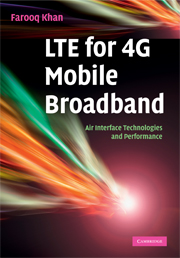Book contents
- Frontmatter
- Contents
- Preface
- 1 Introduction
- 2 Network architecture and protocols
- 3 Downlink access
- 4 Single-carrier FDMA
- 5 Reducing uplink signal peakiness
- 6 Transmit diversity
- 7 MIMO spatial multiplexing
- 8 Channel structure and bandwidths
- 9 Cell search and reference signals
- 10 Random access
- 11 Channel coding
- 12 Scheduling, link adaptation and hybrid ARQ
- 13 Power control
- 14 Uplink control signaling
- 15 Downlink control signaling
- 16 Inter-cell interference control
- 17 Single frequency network broadcast
- 18 Spatial channel model
- 19 LTE performance verification
- Index
11 - Channel coding
Published online by Cambridge University Press: 28 February 2011
- Frontmatter
- Contents
- Preface
- 1 Introduction
- 2 Network architecture and protocols
- 3 Downlink access
- 4 Single-carrier FDMA
- 5 Reducing uplink signal peakiness
- 6 Transmit diversity
- 7 MIMO spatial multiplexing
- 8 Channel structure and bandwidths
- 9 Cell search and reference signals
- 10 Random access
- 11 Channel coding
- 12 Scheduling, link adaptation and hybrid ARQ
- 13 Power control
- 14 Uplink control signaling
- 15 Downlink control signaling
- 16 Inter-cell interference control
- 17 Single frequency network broadcast
- 18 Spatial channel model
- 19 LTE performance verification
- Index
Summary
Like other 3G systems, the current HSPA system uses turbo coding as the channel-coding scheme. The LTE system supports peak data rates that are an order of magnitude higher than the current 3 G systems. It is therefore fair to ask the question, can the turbo coding scheme scale to data rates in excess of 100 Mb/s supported by LTE, while maintaining reasonable decoding complexity? This question is particularly important as other coding schemes, which offer inherent parallelism and therefore provide very high decoding speeds such as Low Density Parity Check (LDPC) codes, have recently become available. A major argument against turbo coding schemes is that they are not amenable to parallel implementations thus limiting the achievable decoding speeds. The problem, in fact, lies in the turbo code internal interleaver used in the current HSPA system, which creates memory contention among processors in parallel implementation. Therefore, if the turbo code internal interleaver can somehow be made contention free, it becomes possible for turbo code to benefit from parallel processing and hence achieve high decoding speeds.
LDPC codes
Similar to turbo codes, LDPC codes are near-Shannon limit error correcting codes. More recently, LDPC codes have been adopted in standards including IEEE 802.16e wireless MAN, IEEE 802.11n wireless LAN and digital video broadcast DVB-S2. The LDPC codes allow an extremely flexible code design that can be tailored to achieve efficient encoding and decoding. The interest in LDPC codes comes from their potential to achieve very high throughput (due to the inherent parallelism of the decoding algorithm) while maintaining good error-correcting performance and low decoding complexity.
- Type
- Chapter
- Information
- LTE for 4G Mobile BroadbandAir Interface Technologies and Performance, pp. 251 - 290Publisher: Cambridge University PressPrint publication year: 2009

